eISSN: 2469-2794


Review Article Volume 11 Issue 1
Nottingham Trent University, United Kingdom
Correspondence: Andrew O’Hagan, Nottingham Trent University School of Science & Technology, Erasmus Darwin, Room 230, Nottingham Trent University, Clifton Lane, Nottingham, NG11 8NS, United Kingdom
Received: March 28, 2023 | Published: April 13, 2023
Citation: O’Hagan A, Deliparaskevas S. International heroin trafficking an overview. Forensic Res Criminol Int J. 2023;11(1):9-17. DOI: 10.15406/frcij.2023.11.00362
This study of international heroin trafficking reveals that it is estimated to generate in the region of £55 billion annually with more than 15 million consumers worldwide. To the present-day, Afghanistan remains at the forefront of opium cultivation with over 131,000 hectares actively employed. The complexity of trafficking drugs is evolving rapidly with the levels of corruption involving several organized crime organizations becoming more prevalent. Nevertheless, the law enforcement in each country employs their own initiatives to battle this war on drugs, with an evident increase in statistics related to seizures and arrests. Classified as a Class A drug in the United Kingdom and a major investigations issue in the rest of the world, authorities are trying to reduce the enormous heroin empire, illicit organizations have laid the foundations for.
Keywords: heroin, Afghanistan, DEA, golden triangle, Mexico, U.S, U.K, Balkans
Heroin as a class a drug
Donna, in her mid-thirties, was suffering from heroin addiction. The death of her father, along with the birth of her daughter, made her slowly crawl towards a high she would later regret. She stated that her using “made her turn into a not nice person’’.1 Her day-to-day life consisted of necessary heroin use to function. She describes her life going downhill, feeling nauseous, sweating, shaking and constantly aching. Heroin is a drug derived from Opium. It is obtained from the unripe seeds of the flower Poppy. When the flower is mature enough for the petals to fall, incision of the seed capsules, allows for a milky latex to be collected. Upon reacting with the atmosphere, the concentrate turns brown. Raw opium can be broken into a powder, sold as chunks, bricks, or processed further to produce heroin, morphine, and codeine derivatives. The narcotic products are classified in the opiates category.2 Scientists and botanists across the world are still puzzled by the geographical origin of the poppy. More specifically, that is owned to the plant’s adaptive abilities, allowing it to grow on most ecological environments. Opium poppies can be grown and found in most places across Asia, Europe, as well as North and South America Figure 1.3,4
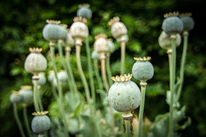
Figure 1 Opium Poppies.4
Heroin and other opioids are now classed as Class A narcotics under the Misuse of Drugs Act of 1971. As a result, sentence for supply and distribution, could be life. Furthermore, Section 9 of this act forbids the use and possession of any prepared opium. Despite this, drug-related deaths are the leading cause of death in the UK. Heroin is administered in a variety of methods, and the effects vary depending on how it is. Syringe injection is the most usual method, followed by smoking and rectal administration. The typical effects last two to four hours and begin quickly after injection.5 The drug is made by the chemical alteration of morphine, originating from the poppies, making heroin a semi-synthetic drug.
In its essence there are different types of heroin, dependant on its quality and type. However, all of them are feasible to cause serious harm to the user. Ways of administration also carry a critical role on the addiction scale and effects of the drug, with syringe al injection being the most frequent.6 Heroin acquired on the streets, commonly known as ‘illicit’, cannot typically be found to be more than 50% pure. Subsequent compounds used in the manufacturing operation, are added to enhance, or replicate the impact. Namely other opioids or sedative medications, and substances to bulk it up, such as paracetamol, are all possible ingredients. Injecting heroin, like injecting any other illicit drug, carries the highest risk. Bacterial, fungal, and viral infections, as well as abscesses at the injection site. Vein collapse, and diseases such as hepatitis, HIV, and other pathogens, are among them. Injecting, especially intravenously, produces a powerful and addicting euphoric surge. It's difficult to adjust to using less intense ways after injecting heroin into one's veins on a routine basis.6
It operates by modulating reward, pleasure, and pain perception receptors in the brain. The diamorphine molecule has been chemically modified to provide a medication that passes the blood-brain membrane more efficiently than morphine, resulting in a significant spike in brain levels from said stimulant and what users refer to as a 'rush.' Serious risks when overdosing include respiratory depression, deriving the body from its natural ability to breathe. In addition, Aspiration from vomit is common, since the sedation of the use, prompts the body to vomit. Furthermore, many heroin addicts have died from an overdose on a dose of medication that they have already taken numerous times. This can occur because of a decline in tolerance. Without heroin, or merely weak heroin, tolerance will be lessened in a timely manner, implying that a previously typical amount could induce overdose.6 A historic review is included below in Table 1.
|
Year taking place |
Historic review |
|
early 1920s |
The prohibition of illegal substances dates to the early 1920s. In July 1916, the "Defense of the Realm Act" made it illegal to use controlled substances like opioids on anyone who wasn't permitted to have them. Even though they take place in the United Kingdom, they begin to revolve around London. |
|
1926 |
The Morphine and Heroin Addiction Committee, also known as Rolleston, produced reports in 1926.The first attempts were taken to urge people not to consume opioids illegally. That was the situation since even licensed inspectors were using opioids at the time. There were numerous reports of Metropolitan Police officers taking opioids including Heroin and Cocaine. As a result, the 'British System' was formed expressly in 1921. Only medical professors and practitioners were entitled to keep authorization for the possession and prescribing of opioids under this rule. The Dangerous Drugs Act of 1920 would penalize anyone who did not follow those terms. These, according to reports, bear the imprints of today's 'dangerous drug' regulations.9 |
|
1935 |
There are always possibilities to be found. In this scenario, set in the year 1935, persons with the capacity to administer medications like opioids to others fell into one of three categories. The sincere, generous, and trusting. It goes without saying that those in the first category attempted to keep their recommended doses to a bare minimum and would always recommend that persons seeking help for opioid addiction seek treatment in a hospital. |
Table 1 Historic review of heroin in the United Kingdom
Regrettably, those who fell into the first category were in the minority. The trusting and charitable ones allegedly lied about how many opioids a patient was taking and were unafraid to believe each patient's story. More specifically, the figures were so dissimilar that the doctor would claim to have prescribed two heroin tablets per day when the patient required more than 100 each week.7 News items from the time can assist paint a picture of the differences between then and now Figure 2. Nevertheless, the United Kingdom is only a small percentage of the countries suffering from illegal drug trafficking. This report aims to provide an overview of international heroin trafficking. Mentioned are countries such as Afghanistan, China, and Mexico, who manufacture heroin for the globe. Trafficking routes, accompanied by statistics for seizures and arrests and will be discussed in detail. Information on how the law enforcement is trying to counteract this enormous problem will also be reflected upon. Associated groups aiding the distribution and their chain of hierarchy is an important parameter that will also be considered in this piece.

Figure 2 Article from Morning Advertiser.7
Afghanistan in relation to heroin trafficking
A country that plays a major role in Heroin trafficking is Afghanistan. As of today, with over 40 million in population and 32 provinces, Afghanistan produces 85-90% of heroin demand across the globe.8 With all 32 provinces cultivating the poppy flower, it is estimated that 131,000 hectares around the country of poppy exist, with an average 32kg per hectare produced. Figure 3 below, more specifically identifies the spread of cultivation.9 However, there is undeniably a high demand on the drug, with Afghan heroin being trafficked to every part of the world, minus Latin America. Traditionally, the route preferred is through the Balkan. As of 2015, the United Nations have identified that the Balkan route is ideal for supplying ‘single destination markets’, whereas a vast network is available now, supplying diverse destinations Figure 4.10 It is evident that there is not a general flow of trafficking, yet a vast network of routes. The United Nations of Drug Trafficking (UNODC) have identified that there are three routes taken, the Balkan, Northern, and Southern. As mentioned, the Balkan route remains a tradition, however, the Southern route serves a wider audience, requiring more focus. Transportation methods within the Southern route divide in four ways, together with their respective subtypes. Table 2 distinguishes between the four:

Figure 3 Poppy cultivation in Afghanistan.9
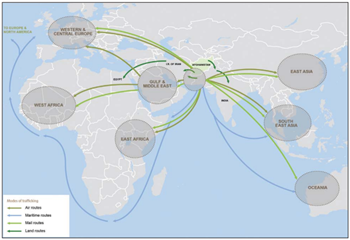
Figure 4 Heroin trafficking routes across the South.10
|
Transportation method |
Tools utilized |
|
Trafficking by Post |
- |
|
Trafficking by Sea |
Cargo/Small boats |
|
Trafficking by Air |
Cargo/Luggage/Hidden in bodies |
|
Trafficking by Land |
Vehicles through trade crossing/Unguarded Borders/ Hidden on bodies |
Table 2 Transportation methods in Afghanistan and tools utilized
Trafficking by land utilizes the use of two destinations mostly. The further reaches it can extend to is India through Pakistan and the Southern coast through the Republic of Iran. There are some dominant routes preferred when heroin is trafficked by land. Namely, those are through the province of Baluchistan of Pakistan, as well as the Southern Eastern province of the Islamic Republic of Iran.10 When Heroin is trafficked using the water networks, the use of sea and dry ports along the South-West of Asia has seen an increase, due to general trade demand. Furthermore, traffickers utilized smaller jetties to move heroin to the Gulf region, Gulf of Oman, and further South to East Africa, where official ports are not necessary to use Figure 5. Reportedly, the use of coastal areas of Afghanistan, Pakistan and the Islamic republic of Iran has seen an increasing number of opiates, with heroin being the main product, seizure. Outside those regions, seaports and high seas have seen the largest seizures recorded. Records like that, illustrate that heroin’s preferred transportation method is mainly trafficked by sea only in the largest quantities available. Moreover, significant heroin shipments are detected in Europe, indicating that the points of departure are otherwise, uncharted.10 Drugs hidden in bodies is a reference to the stuffing of one’s internally. Commonly known as the swallower, that is the most extreme method used to traffic today. The person, otherwise known as a mule, will swallow around 1kg of drugs in packets quantifying around 8-10g each.11 Undeniably, if any of these package’s puncture, the mule will overdose on a fatal dose immediately.12 The swallower will be met by a representative 1-3 days before and slowly begin the ingestion of said class A drugs. It is common that the last package will be different in color from the previous ones, enabling the courier to be certain that the amount digested is correct.
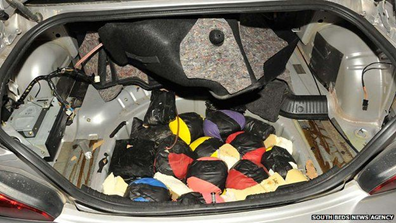
Figure 5 Afghan heroin hidden in car’s back, est. 230kg.11
The individual will lubricate their throat with moisturizer before swallowing each package, which consists of an egg-shaped solid lump of heroin covered in cling film and a condom. Swallowing the packages becomes more difficult, therefore, they may frequently enlist the assistance of another person or a representative to help push the packets down the throat and into the stomach.12
The golden triangle
Deviating from this, a record is held historically for the quickest rise in heroin consumption to date. Occurring during the 1980’s, heroin from South-West Asia saw a shortage brought by the drought severely affecting production at the time. Reportedly values were as follows Table 3:
|
The misuse of drugs act regulations 1971 |
|
|
Chapter 38, section 3, subsection 1 |
Importation and exportation of such substances is illegal.38 |
|
Chapter 38, section 4, utilizing section 28, subsections 1-3 |
Production and supply, together with being concerned in the production or supply of such drugs, is an offence. Especially so when referring to a class A drug, it is most important to pursue the conspiracy breaking these rules, and not the branches it grows along with.39 |
Table 3 Misuse of Drugs Act Regulations
Resulting in the drought was also the successful prohibition of the Drug Enforcement Administration (DEA) in Bangkok.13 Nonetheless, South-West Asian (china white) heroin resurfaced. In addition, Afghan and Pakistani heroin saw an increase in exports to Europe. The record mentioned before, was recorded in Pakistan, rising from 5,000 to 650,000 users just between 1980 and 1986. The mid 2000’s saw an estimate of 700,000 opiate consumers in the country, where heroin dominated half a million of them.13
Remaining in Asia, a significant distance covered between the borders of mountainous Burma, Laos, and Thailand, is referred to as the ‘Golden Triangle’ of heroin production in these areas, consisting of 150,000 square miles. Most border regions between said places are included in the distance covered, despite the Mekong River flowing between all three countries, attracting a lot of tourist attention. Figure 6 depicts the size of heroin production across Burma, throughout the early 2000’s. The reason behind this reduction being the collapse of Khun Sa’s Mong Tai army (MTA) in 1996. Drug traffickers at the time recognized that the Chinese route, offers a greater opportunity of transportation than the Thai route. Reluctancy from group leaders was at a high, because of fear that china could potentially shut the borders down isolating the area Figure 7.14 Nevertheless, the routes depicted in Figure 7 were encouraged by dominantly ethnic Chinese traffickers, due to the advantages provided by the geographical proximity, such as enhanced road conditions, and most importantly, linguistic, and cultural familiarities. What is most fascinating in Asian drug market though, is that traditionally, no triads carry substantial evidence to be accused of organized crime. Traditional Chinese criminal organizations, including Hong Kong based triads and Taiwan based syndicates, have been accused of participating actively in international drug trafficking in Asia and Oceania for a long time.15
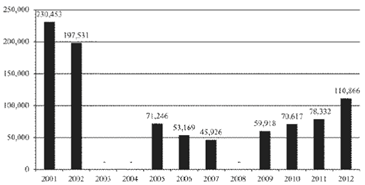
Figure 6 Poppy cultivation in Burma in acres.14
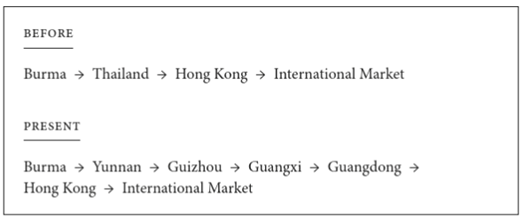
Figure 7 Change in pattern of Golden Triangle’s heroin trafficking routes.14
Law enforcement officials of the U.S sacrificed months of resources in investigating addicts, dealers, and traffickers in China, throughout the form of interviews. The UNODC have since reportedly found no systematic linkage between drug trafficking and traditional criminal organizations. Three factors contributed into the making of this decision. It is known that drug trafficking as a behavior is organized. However so, there are different degrees to an organization in within. Secondly, the U.S drug enforcement was preoccupied with drug cartels and organizations in Mexico, allowing no other room of exploration outside. Nevertheless, Triad societies have long fascinated western scholars and policy makers, when it came to organized drug trafficking, whereas their involvement bears little to no evidence to make a solid substantiation.15 See U.S drug enforcement officials report Figure 8:

Figure 8 U.S officials on Chinese drug trafficking.14
Mexico-US heroin relations
The United States have seen a rise in the abuse of heroin and other opiates since 2016. Estimation in the statistical department identified, over 940,000 individuals reporting the use of heroin. Similar to the abuse, there has been a proportional increase in the production and trafficking of said drug, fueling its availability, mainly by Mexican criminal networks. Heroin transported into the U.S is now lesser in the amounts from South-West Asia and South America, since shares have been increased with Mexico, the key producers of heroin trafficked into the States.16 According to the DEA, the South-West border is where heroin is mainly imported into the U.S from Mexican transnational criminal organizations (TCO). Most of the product imported controls the flow by personal transportation vehicles entering at legal ports of entry, followed by tractor-trailers, where legal goods mask the heroin brought over. In the single year between 2016-2017, Mexican poppy cultivation has increased by a 35% rate, producing around 111 metric tons of heroin. It is certain that the figures are on a pedestal when talking about the States and Mexico on their own, however that amount is considered a ‘drought’ when compared to the production of Afghanistan and Pakistan. It is most interesting how big the supply chain is on these countries, and how they are in utter control of a worldwide distribution network. On the other hand, it is worth mentioning that Mexico’s geography is also a vital parameter in the above. With an adaptive climate from tropical to desert, and a range of terrains, cultivation in this land becomes more difficult. The country is long and thin, with landscape from low coastal plains to high plateaus and deserts, detection by the law becomes a greater issue. Furthermore, in 2022, deforestation is considered a national worry issue in Mexico, allowing for a greater depth of vision when the authorities try to detect illicit drug production.17 Be that as it may, the amount of heroin produced is still worthy of attention, when parameters such as these are taken into consideration. It is expected that when compared in numbers with the world’s leaders in heroin production, the numbers would seem very low. Despite that, when an outsider views information as such and critically assesses the above, Mexico produces a large amount of heroin, although it is ill-treated by its geography.
Reverting to the subject, Mexican black tar, brown powder heroin, has historically been trafficked West of the Mississippi River, while the East side had always been dominated by South America. Nonetheless, U.S gangs have now formed professional relationships with Mexican traffickers, allowing white powder heroin to be moved in both sides. U.S gangs are responsible for the trafficking and distribution within the country, whereas their endgame is the revenue gained from said illicit activities.16 The following statistics were provided by the DEA Figure 9:
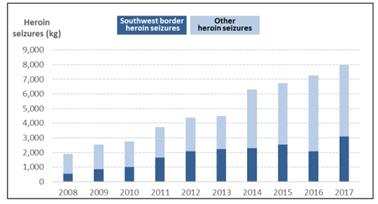
Figure 9 Heroin seized in the United States between 2008-2017.16
According to UNODC, seizure data bears a relationship with data such as drug prices and purity, serving as a drug market indicator. The relationship is often proportional when it comes to seizures, purity levels and overall drug supply, whereas reverse proportional when it comes to drug prices. More specifically, an increase in drug prices, and a decrease in seizures and purity levels, suggest that there is a decline in overall drug supply. The opposite also applies. Figure 9 suggests that purity shows fluctuation, however, remains generally elevated over the years described. The retail level price remaining lower than in the 1980’s, combined with the purity and seizures, suggests that there is an increased supply for the U.S market.16 U.S law enforcement has donated efforts into seizing contraband by buyers concealing the drugs. That translates into an increase in seizures, mainly for offences that fall under the trafficking path and not just simple possession Figure 10.17,18

Figure 10 DEA heroin arrests.16
Recent statements report on how Mexican traffickers have discovered a profound way of transporting illicit drugs into the States. Trafficking through the borders has now become an obvious choice, however a profound initiative has surfaced. The use of subterranean transportation tunnels allows for undetected movement below the borders. The size of these tunnels’ accounts for the structural and technological philosophies considered for each one’s constructed. Most vary from each other, with some being unventilated, narrow, and short. Whereas those created for distances of several miles long, are outfitted with rail systems, ventilation, and appropriate lighting, to haul cargo across.19 CNN reported that over 75 of said tunnels exist between Mexico and the United States, with an overwhelming majority of them located in Arizona and California.20
Heroin health risks are deemed destructive, with potential overdose and death on every single use. This fact has fabricated the U.S official’s National Drug Threat Assessment, and since 2018, heroin poses the top place. Figure 10 reassures of the fact that law enforcement has been tackling illicit drugs in a successful initiative. Not all the efforts put in from officials serve as an immediate goal to target trafficking, however that remains the end goal. In an ever-evolving drug culture, where trafficking threats keep arising, the States have developed strategies to counter said threats.16
As of 2015, the U.S have launched a new initiative, called the National Heroin Task Force. As a primary objective, ‘’to curtail the escalating overdose epidemic and death rates’’,21 the task force addresses countering the issue. The federal government prioritizes heroin distribution arrests and improves investigative and prosecution procedures to target the heroin supply chain, especially when the drug results in a fatality. The report identified that tackling the source of heroin and cutting its flow could result in saving innocents. The task force highlights their methodology by using synchronized, real-time data exchange to destabilize the supply of drugs and concentrate preventive, therapy, and intervention resources where they are most needed.21 Noteworthy is the ongoing evolution of the relationship between the DEA and medical practitioners. Further than this initiative, the Controlled Substances Act in the States is one that law enforcement is ensuring registrants that manufacture or export-controlled substances comply under. Their engagement in this problem, and their concern in illicit or controlled substances not being diverted to illegitimate use is admirable from an outside perspective. That is achieved by a system created by the DEA, in which every registrant in relation to controlled substances is regulated.21 Intriguing is the fact on how the DEA tries not only to just control the current ongoing issue with illicit substances but prevent anyone under their review regulate controlled substances to the wrong individuals.
Ukraine a producer in Europe
A study founded by the US tackles how European heroin markets are aided from South-West heroin, with Ukraine as a prducer. Europe has been struggling with opiate consumption, where opiates not only account for 75% of all treatment demands, but also for the highest number of mortality rates. The reason being is the growing amount of cultivation and trafficking through Ukraine. Fertilizing approximately 300 hectares of poppy, Ukraine is now a considered a narcotics producer on their own Figure 11.
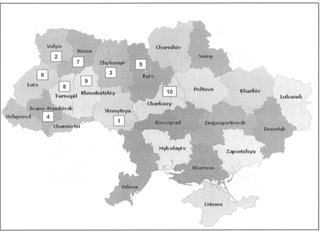
Figure 11 Poppy cultivation areas in Ukraine.22
Figure 12 critically assesses the cultivation around the areas mentioned in Figure 11. With the disintegration of the former Soviet Union, heroin traffickers now have alternatives to their conventional and carefully monitored intermodal routes through Pakistan and Iran. Less restrictive border controls, macroeconomic instability, corruption, and the region's burgeoning drug markets have made Central Asia an increasingly crucial transit area for opium and heroin shipments from Afghanistan.22 Despite the above information being from 2001, comparing Ukraine’s poppy cultivation to Afghanistan’s is captivating. Like Mexico, when comparing numbers, Ukraine’s hectares are almost non-existent in contrast to Afghanistan. Nevertheless, Ukraine is mainly a flat country, with a 5% of mountainside and slopes in Crimea. Its relationship with the sea bears more weight on poppy cultivation, making it more difficult to grow. Therefore, any amount cultivated is significant enough and noteworthy.23 Ukraine occupying 0.4% of dry land across the globe, allows for a wider perspective on the problem severity of cultivating opium, therefore any number of hectares, no matter how lesser than Afghanistan is commendable Figure 13.

Figure 12 Ukraine areas and poppy cultivation.22
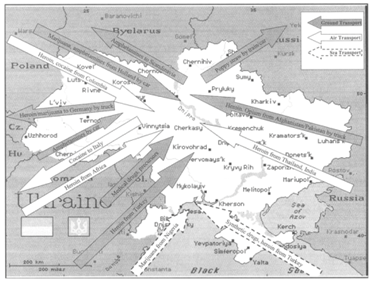
Figure 13 Imports and exports of drugs in Ukraine.22
Despite the information on Figure 11,12 being outdated, it is still undeniable that the heroin produced in Ukraine does not tackle close to the amount exported from Afghanistan. Afghan heroin, as mentioned prior in this report, is primarily responsible for opium trafficked into Europe. The above figure, allows for a perspective on how heroin is smuggled into Ukraine, companioned by other drugs. 75% of heroin smuggled through Europe, is trafficked from Afghanistan, to Turkey, making its way through the Northern Balkan route, across the Black Sea to various ports in Ukraine. It is estimated that there are 1.5 million trucks, 4 million private cars and a quarter million passenger trains that smuggle heroin through yearly. The most frequent way is transporting low amounts, generally 20-50kg hidden in trucks. The product is then moved into Poland via trucks or cars Figure 14.24,25

Figure 14 Heroin seized from sea vessel est. 400kg.25
Europe in relation to heroin trafficking
According to the European Report in 2015, heroin accounts for a total of 28 million dollars annually, when production, trafficking and consumption are included. The number rises exponentially when the resources needed to counteract such a movement are accounted for. These mainly being law enforcement and health costs.26 Furthermore, the record for overdoses has been proportionate with the purity of heroin trafficked in Europe, maintaining a steady increase. This helps to explain why heroin is regarded as Europe's most dangerous illicit substance.27 The main difference in Europe, is that the heroin trade network, has more redundant linkages and is more widespread than the cocaine trade network, leading researchers to argue that it may be more impervious to supply-reduction interventions. Heroin in the E.U is available mainly in two forms. The first being brown heroin from Afghanistan and the second, less frequent, being white heroin from South-East Asia.28
A rising concern for local authorities, however, identifies 14 emerging synthetic opioids reported in Europe since 2005. Iran, Afghanistan, and Pakistan are the primary sources of most heroin found in Europe. Nonetheless, in 2014, two laboratories converting heroin in Spain were discovered. That could suggest a manufacture of a primal stage heroin, where it is not easily detected when trafficked throughout Europe, however, is perfected within the borders. As mentioned previously, most of Europe’s homemade poppy production is limited to Eastern Europe. Opioids trafficked into are smuggled in two major ways, the ‘Balkan and Southern’ routes.26 A course in which Turkey, Bulgaria, and Romania transport heroin by land, is the Balkan route, where the drugs reach a destination of Central, Southern, and Western Europe. South, Western, and Central Africa utilize a route which has gained importance in the recent years, by trafficking heroin using air and sea vehicles. Figure 15 details on how the southern route is composed of Figure 15.

Figure 15 Southern heroin trafficking route.26
It is evident by the figure above, that the Southern route has grown in importance. That is because there are many branches utilized throughout the trafficking process. Using various transportation methods, it is becoming more difficult for the authorities to intercept such cargoes. However, the branch most important to Europe, is trafficked from the Arabian Sea and the Red Sea into the Suez Canal and the Mediterranean Sea to reach EU or Turkish ports, primarily via containers.26 Turkey has set a record of heroin seized, highest than the rest of Europe’s amount combined, at 13.5 tones seized in 2013. Europol intelligence identifies, Turkish OCGs as the primary importers of heroin in European regions. Controlling various supply chain links and maintaining relationships with producing countries. The article fails to mention reasons as to why that might be the case, however it is evident that respect between Turkey and Afghanistan exists. To further reinforce such a fact, a quote from a 2015 news website, Anadolu Agency, stated:
“When asked about what Afghan people think of the Turkish military, jahoon said that since 2001 Turkish troops in Afghanistan have been nothing but helpful to Afghan troops, by training them and protecting the peaceful environment. Afghan people love Turkish soldiers in Afghanistan like their sons, they are helping Afghan people as much as they can “29
One could argue that a close relationship between the countries does exist, however there is insufficient evidence to assume illicit relations. Nonetheless, it is important to understand the facts. Turkey is an ambassador for heroin trafficking in the EU, with a large connective network and tons of product seized in the past years. Afghanistan, undeniably, bears the foundation to such illegal activities, and the relationship between the two is at great terms. The above is based on facts and not assumptions made, therefore, one could only question.
Heroin in the United Kingdom
In the past year, withdrawn has the United Kingdom from the European Union. The U.K is composed of four countries, England, Wales, Scotland, and Northern Ireland.30 In regard to the cultural links of the countries mentioned above, with the producing countries, detecting heroin trafficked in the U.K is a problem on the rise. The National Crime Agency reports heroin bears an annual cost of £10.7 billion, in resources spent on its investigation.31,32 The product trafficked is most often through the same methods used in the Southern and Balkan route. That is namely air, sea, and land. Via the use of body stuffing, heroin is trafficked at a low cost, and a payment secured for the mules after their delivery of the product. Contact kept with organized crime groups within Britain allows for more secure ways of trafficking. Their increasing awareness results in more creative ways of smuggling the drugs, keeping the product undetected Figure 16. Figure 17 highlights those vast resources. The National Crime Agency (NCA), accounts that the plethora of heroin trafficking into the U.K mainly originates from Afghanistan. With the trend rising the past half decade, they report 38 tones of opioids are consumed in England and Wales. The Balkan Road route is most utilized when drugs are trafficked into the country.33 Organized crime groups follow a common pattern when it comes to diversifying their strategies. More specifically, in the U.K, the drug supply chain is illustrated in Table 4 below:

Figure 16 Banana concealing drugs, flight from Ghana to Heathrow.32

Figure 17 Inspections completed by law in the U.K in 2019/2020.38
|
Role |
Duty |
|
Manufacturer |
The people responsible to produce the opium, and manufacturing of heroin. They are often mistreated when it comes payment, earning small fractions of the true value. |
|
Global trafficker |
Wealthy individuals within organized drug and crime syndicates. Worldwide relations are well established, and their profits are vast. |
|
Continental distributor |
Members of crime syndicates, whose activities involve purchase/reselling and logistics of product. Direct impact to the United Kingdom. |
|
Importer |
Established criminal organizations in the U.K, with branches across the globe. Importation methods vary based on volume of product. High income, yet expensive resources, considering transportation and security. |
|
National distributor |
Individuals purchasing large quantities of imports, distributing to lower chains. Profits remain high. |
|
Regional supplier |
Distributors of the class A drug locally in the country, most often trafficking multi-ounce packages. Transportation ranges from vehicles to trusted couriers. Profits are still substantial. |
|
Local supplier |
Suppliers of the drug to the street dealers. Income is lower than the above ranks, however bulk selling could enhance such profits. |
|
Street dealer |
Lowest in the supply chain. Minimal profits, with local area, city, distribution. Profits could often satisfy their own hunger for the substance. |
Table 4 Drug supply chain in the U.K12
The table above details the trafficking pyramid in the U.K and most often within any country trafficking illicit substances. Law enforcements are trying to massively decrease the effect of such activities, and that is as mentioned previously, done by targeting for the ‘brain’ of the operations and not the muscle. Police surveillance is critical into achieving such a target. In the UK, MI5 and MI6 carry out surveillance tactics only when it is covert, meaning the subject is unaware that such actions are taking place. There are two categories when it comes to surveillance. The first being Directed, utilizing the use of individuals and specialists. Regulated by the Investigatory Powers Act 2000 (RIPA), an investigation as such is carried out by covertly monitoring the target’s movements, activities, and conversations. Surveillance officers are working in co-operation with the police, often with the use of observatory positions, vehicles or on foot.34
The second type is Intrusive surveillance. As described by the characterization, experts install eavesdropping devices on a target’s residential premises or private vehicles. For such a surveillance to take place, the Secretary of State is required to authorize it, under the RIPA 2000, and issue a warrant. A property warrant is also required in most cases, under the Intelligence Services Act 1994, for the covert installation of a device. Products from an eavesdropping device are allowed by law to be used as evidence in court. On such account, the Secretary of State needs to be presenting with fact and evidence on why such a surveillance carried out is both necessary and proportionate.35 On the other hand, in the States, such surveillance investigations are classified under the tab ‘Major Investigations’. The United Nations identify organizations and individuals responsible for producing and trafficking illicit substances, as part of those investigations. These require long periods of time to be properly carried out with the combined forces of not only federal and state law agencies, but also large local law enforcement units. Sizeable distances and specialized expertise are reasons as to why local forces are not the only one’s participating in such investigations. For one to succeed, an informant or undercover officer’s role is vital. Focus on tax and bank records is given when such a process is carried out. Doing so allows the law to utilize their “Racketeer Influenced and Corrupt Organization (RICO) and Continuing Criminal Enterprise (CCE) laws’’ when prosecuting.36
Categorically, large organizations are part of a major investigation because a successful prosecution, could significantly impact drug availability. Hence, two main tactics are integrated, when it comes to surveillance. Firstly, focusing on the entire trafficking networks, with the use of maps and evidence boards, and not solely the ‘Top Men’ assists in a better understanding of their way of operating. Lastly, seizures and arrests are more effective when the law obtains all assets of the networks, effectively stranding the organizations. Simultaneous use of these tactics is proven to result in minimizing illicit drug flow.36 The above information originates from outdated articles, however MI5 and UNODC have updated their information. In both countries discussed, funding originates from governmental grants, whenever a major investigation is conducted. A budget is set on the operations and every agent, and authority officer must be very delicate with the ways each dollar/pound is spent. The costs for training are the one’s considered first, and it is then integrated into how each situation is carried out.38 It is worth mentioning that the United States most certainly exceed the budget the United Kingdom has. A very logical argument when taken into consideration are the facts of how big the States are. Each state operates with their own law, however federal activities have a higher hierarchy when the target is bringing down a drug trafficking organization. For both the U.S and U.K, heroin is mainly imported. Mexico and Afghanistan are the primary suppliers respectively. When it comes to their tracking such a target, their powers are mainly within their locations and not in another country. That makes it objectively difficult for them to infiltrate an organization. Therefore, surveillance provides an assistance, by observing the targets undetected, and hoping for some mistakes to happen. It is fascinating how essentially the law is aiming for the members affiliated with a drugs organization, to expose themselves.
Figure 17 signifies the intelligence inspections performed in the U.K. It is evident that local authorities performed the most inspections throughout the year. Taken into consideration should be the fact that COVID-19 originated and peaked at those times. Therefore, law enforcement and other authorities had those issues to compete with as well. Noble is the fact that despite COVID, the numbers remain high. In October 2019, the U.K and U.S government signed the UK-US Bilateral Data Access Agreement Table 5. This idea is beneficial yet could potentially be catastrophic. Heroin is trafficked in U.K and the States by major producing countries. Information on criminal organizations affecting both, from regional and continental distributors to importers, could be proven useful shared between the two. Saving time and resources on surveillance that would otherwise be required, providing information that would help plan an investigation in a different, smarter way. It is certain that specific law procedures are followed by each and vary in different parts, however some targets could potentially be similar, therefore keeping up to track, when it is only needed, provides an upper hand.
|
UK-US Bilateral Agreement |
Regulations |
|
Original agreement |
It grants public authorities access to cloud information relating to prevention, investigation, detection, and prosecution of serious crime. In essence, evidence and information gathered from illicit drug organizations is now able to be shared between the two governments. As agreed between both parties, access to such data is subject to domestic legislation and the agreement. |
|
Updated regulations |
Enacted to the agreement in September 2020, section 229 of the Investigatory Powers Act 2016 (IPA), now requires the Investigatory Powers Commissioner (IPA) to ensure that proper use is being complied with. Moreover, prosecuting authorities, under the Crime Act 2019 can apply and receive cloud data directly from service providers, for drug investigation use. |
Table 5 UK-US Bilateral Agreement regulations38
On the contrary, a great risk is taken by sharing major drug organization information from electronic services. It is only natural to assume that a firewall of supreme encryption is set up. In any case where that firewall was to be breached or hacked, information vital to the country’s largest, most major investigations could be leaked and great problems could arise. Technology is constantly evolving on the daily and encryption is becoming weaker. A government’s private information possesses a serious threat if exposed. What is most intriguing about that agreement, is that how it has only been reached with USA and Great Britain. For the U.K to share such information with another country, an international co-operation agreement is required. The transport of drugs within the U.K is mainly regulated by a drug business model known as county lines. Table 6 further illustrates:
|
Drug business model |
Ways of operating |
|
2015 was the year the NCA officially titled them as such. The term used refers to them transporting illicit drugs from urban areas to towns handpicked depending on the profits able to be made. Their primary method of communication includes using dedicated mobile lines, known as ‘deal lines’ to take orders. NCA reports that heroin remains the drug supplied most frequently. |
|
|
County Lines |
Targeted by those groups are young adults and individuals mainly living in poverty or have prior criminal involvement. Adults and kids such as, agree to aiding the criminal drug complex, after being offered a fake better future. Their vulnerabilities are exposed, and they are given to believe their life could improve upon assisting such organizations. |
Table 6 County lines as a drug business model and their ways of operating38
The sad reality however is that none of that is true, and they are only risking their own lives, enabling ‘Top Men’ behind those drug complexes to further conceal their identities. Nonetheless, those moral issues do not bother the people behind the scenes, as their main concern is to traffic drugs and earn more profits. NCA states that offenders use various violent methods to ensure the control of those recruited. To them, the victims are replaceable, and their wellbeing is none of their concern.
To conclude, the reason this is mentioned, is to reflect on the progress that anti-criminal government organizations are making. Reviews of drug organizations and their ways of operating, allows for a better understanding of their thought process. As previously outlined, statistics portray a rise in heroin seizures and associated arrests, and the law has new profound ways of targeting drug conspiracies. It is though, undeniable that these people are constantly improving their hiding of evidence and are increasingly aware. Criminals nowadays are a real challenge to any country’s law enforcement. Both parties are constantly trying to exploit each other, learning new tactics and tricks to camouflage their work. On the one hand, MI6, NCA, FBI, and police across each continent, are constantly reviewing their research articles and annual reports, allowing for a greater understanding of how crime is regulated in their areas Figure 18. The above figure captures the increasing identification resources law enforcement is evolving into. These databases are modernized and polished in the highest of standards. On the other hand, drug trafficking networks and drug warlords are employing various methods to counteracts the attack on drugs. These range from simple details, such as burner, pay-as-you-go, phones that are non-traceable to concealing trace evidence and using contacts and associates throughout the world. It is evident therefore, the hierarchy ranks located at the top appear to be untouchable.
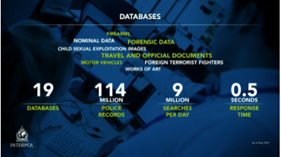
Figure 18 Interpol databases in the US in 2020.40
The supply of illicit drugs around the globe is more sophisticated than it has ever been. Targets are smarter than the years before and law enforcement should employ further strategies to combat the war on drugs. Correct training should be provided to every official working for any anti-drug organization or the law, no matter whether regional or federal. Keeping up with updated training standards is vital for countering a situation that is ever-evolving constantly. Furthermore, annual research articles are as important as field training, aiding the law by keeping them updated with the situation in their respective areas. These should continue to be reviewed yearly, allowing for a more realistic view on the existing problem. Lastly, Interpol has been holding global references on illicit drugs, with over 100 countries’ representatives attending. Conferences as such are critical, due to them providing a wider perspective on worldwide illicit drug trafficking. These should be encouraged more, and held at various stages around the year, keeping everyone updated with the war on drugs. The law is trying hard to counteract the effects enormous drug organizations are having across the world, from innocent people affected to the worldwide economy. Despite this war having just started, agencies across the world should continue their work because for any economic, scientific or health related problem, research is detrimental.
None.
The authors declare that they have no known competing financial interests or personal relationships that could have appeared to influence the work reported on this paper.

©2023 O’Hagan, et al. This is an open access article distributed under the terms of the, which permits unrestricted use, distribution, and build upon your work non-commercially.